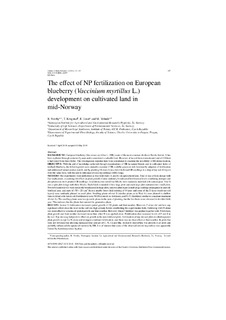| dc.contributor.author | Nestby, Rolf | |
| dc.contributor.author | Krogstad, Tore | |
| dc.contributor.author | Joner, Erik | |
| dc.contributor.author | Vohnik, Martin | |
| dc.date.accessioned | 2015-01-23T09:44:19Z | |
| dc.date.accessioned | 2018-05-29T10:23:27Z | |
| dc.date.available | 2015-01-23T09:44:19Z | |
| dc.date.available | 2018-05-29T10:23:27Z | |
| dc.date.issued | 2014 | |
| dc.identifier.citation | Nestby, R., Krogstad, T., Joner, E., & Vohnik, M. (2014). The effect of NP fertilization on European blueberry (Vaccinium myrtillus L.) development on cultivated land in mid-Norway. Journal of Berry Research, 4(3), 147-157. | nb_NO |
| dc.identifier.issn | 1878-5093 | |
| dc.identifier.uri | http://hdl.handle.net/11250/2499551 | |
| dc.description.abstract | BACKGROUND: European blueberry (Vaccinium myrtillus L.; EB) is one of the most common shrubs in Nordic forests. It has been exploited through centuries by man and is considered a valuable food. However, it has not been domesticated and all EB fruit is harvested from forest fields. The investigations reported here were undertaken to examine the possibility of EB domestication.
OBJECTIVE: With the aid of knowledge achieved through examinations of EB in natural forests and in cultivated fields of lowbush blueberry, the following trials were started to examine if EB could be grown on rich farmland by adaption of fertilization and addition of natural peat as mulch; and by planting EB mats from a forest field and EB seedlings in a strip of top soil (O-layer) from the same field, with the aim to introduce ericoid mycorrhizal (ErM) fungi.
METHOD: The experiments were performed as two field trials (A and B) on agricultural land. Trial A was a block design with four replications, examining the effect on plant growth of nine randomly broadcasted fertilization levels combining nitrogen and phosphorus on fresh planted EB seedlings. In addition, two out of four blocks were randomly mulched with natural peat. Trial B was a split-plot design with three blocks. Each block consisted of two large plots and each large plot contained two small plots. Two fertilization levels were randomly broadcasted in large plots, and two plant types [small plug seedlings propagated in sparsely fertilized peat; and mats of (30 × 20) cm2 from a nearby forest field existing of O-layer and some of the E-layer (wash out soil layer)] were randomly planted in small plots. Seedling plants of trial B (similar plants as in Trial A) were planted in shallow furrows filled with forest soil. Fertilization were N0P0 (control; no fertilizer), and N1P1 (fertilized similar to a medium treatment of trial A). The seedling plants were in a juvenile phase in the year of planting, but the first fruits were observed in the third field year. This indicate that the plants had entered the generative phase.
RESULTS: In trial A fertilization increased spatial growth of EB plants and fruit number. However, P alone did not have any significant effect since the level in the soil was high already before establishing the experimental field. Fertilizing with N alone was most effective in terms of spatial growth and fruit number. However, when P fertilizer was applied together with N fertilizer, plant growth and fruit number increased more than when N was applied alone. Fertilization also increased levels of P and S in the soil. Top-dressing had positive effect on growth in the non-fertilized plots. Fertilization of top-dressed plots resulted in poorer plant growth except for N alone and strongest combined fertilization, and there was no clear effect on fruit number. In plots that were not fertilized top-dressing increased total amount of C, N, Ca and Mg. In trial B mycorrhiza was present in all plots and probably influenced the uptake of nutrients by EB. It is of interest that some of the observed ericoid mycorrhiza was apparently formed by basidiomycetous hyphae.
CONCLUSIONS: EB grown on agricultural land, were juvenile seedlings in trial A, was strongly influenced by NP fertilization. Fertilization with N gave stronger growth than fertilization with P; however, plants fertilized with P grew better than control. Also, fertilization had positive influence on fruit number, either fertilizing with N alone or in combination with P. Top-dressing with natural peat had positive influence on spatial growth, but no clear effect on fruit number. In trial B ericoid mycorrhizal colonization was present in all treatments in both seedlings (juvenile phase) and established plants in mats (generative phase), and it probably influenced uptake of nutrients. It could be suggested that growing EB on cultivated land is possible, but preferably on a more acid soil than in these trials. | nb_NO |
| dc.language.iso | eng | nb_NO |
| dc.rights | Navngivelse-Ikkekommersiell 4.0 Internasjonal | * |
| dc.rights.uri | http://creativecommons.org/licenses/by-nc/4.0/deed.no | * |
| dc.title | The effect of NP fertilization on European blueberry (Vaccinium myrtillus L.) development on cultivated land in mid-Norway. | nb_NO |
| dc.type | Journal article | nb_NO |
| dc.type | Peer reviewed | nb_NO |
| dc.date.updated | 2015-01-23T09:44:19Z | |
| dc.description.version | publishedVersion | nb_NO |
| dc.rights.holder | © 2014 – IOS Press and the authors. All rights reserved This article is published online with Open Access and distributed under the terms of the Creative Commons Attribution Non-Commercial License. | nb_NO |
| dc.source.pagenumber | 147-157 | nb_NO |
| dc.source.volume | 4 | nb_NO |
| dc.source.journal | Journal of Berry Research | nb_NO |
| dc.source.issue | 3 | nb_NO |
| dc.identifier.doi | 10.3233/JBR-140077 | |
| dc.identifier.cristin | 1205260 | |
| dc.relation.project | Norges forskningsråd: 184797 | nb_NO |

